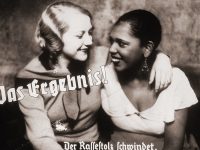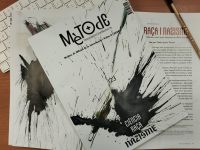Rites of Janus
The educated life and crimes of Dr. Hans Beutelspacher
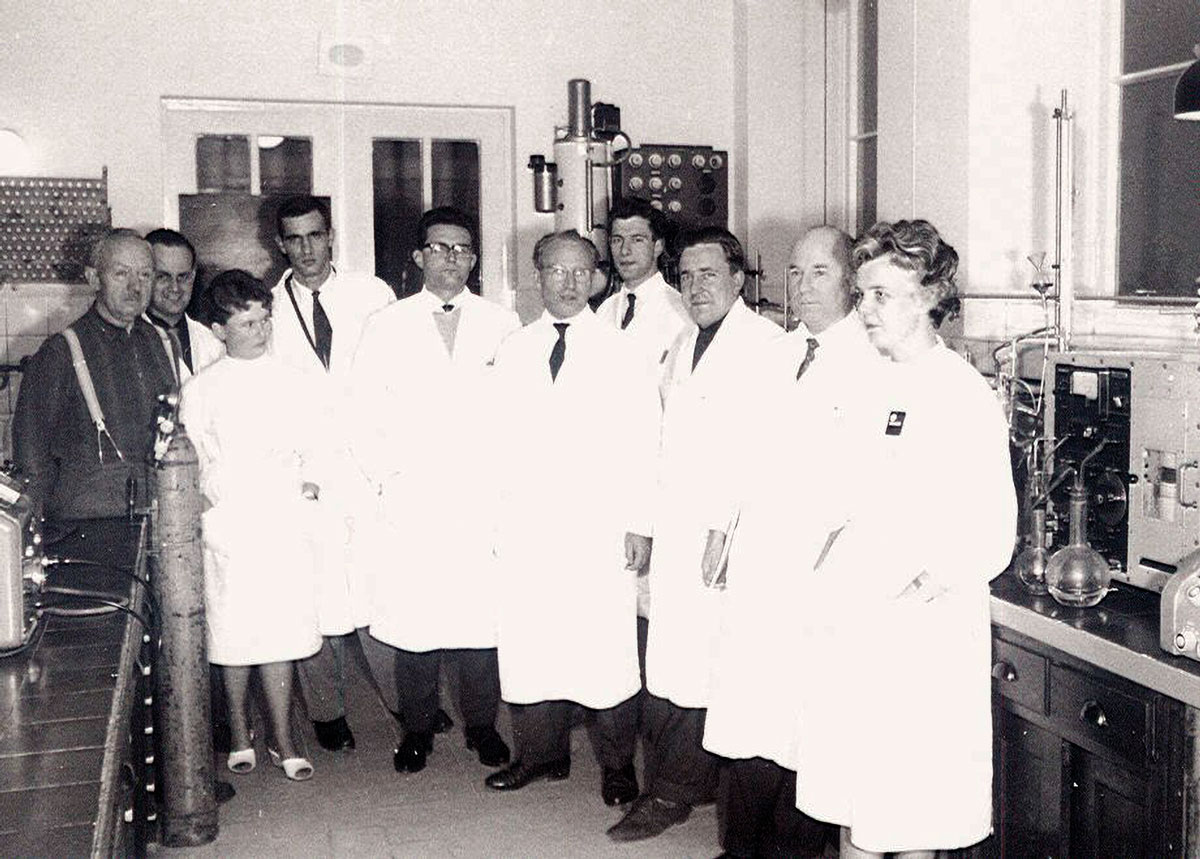
The history that follows will show that the limits of (in)humanity are malleable and readily shifted. Whirled in the chaos of life, ordinary people may suddenly be transformed into monsters, and later, may return calmly to their former nature. It remains unclear why these limits prove so diffuse. Dr. Hans Beutelspacher, whose life story took us ten years to reconstruct, traced this path in both directions, and thus came to embody yet another mystery of the human mind. The possessor of an educated and inventive intelligence, he toyed with monstrous behaviour during World War II, before returning just as effortlessly to his «human» and even benevolent state, later developing a prominent career in the field of soil biochemistry.
Keywords: genocide studies, World War II, Russian history, migration studies, Nazi Germany.
Accounts of totalitarian regimes rarely fail to include the depiction of savage acts and of their heartless perpetrators. Although attempts to read people’s characters from their faces are unscientific, and in the 21st century are even considered insulting, most of us are nevertheless accustomed to imagining monsters and murderers from the past as psychopaths with vacant gazes and dishevelled hair. We find it more comforting to view evil people as repellent examples of human degeneration, individuals whose depraved acts are reflected on the bodily level.
This, however, is merely an illusion.
This article has its origins in the now-distant year of 2013, when in studying the writings of General Gotthard Heinrici, we became interested in his interpreter and adjutant, Doctor Beutelsbacher. A Russian-born German who in civilian life had been an assistant professor at the University of Königsberg, the doctor revealed an outstanding talent for translation – though not for the translating of texts, but for the translating of human lives to the other world.
Yesterday in Likhvin, and today not far from here, Lieutenant Beutelsbacher did away with a total of 12 partisans. I would never have thought that this inconspicuous little man would be so energetic. He is exacting vengeance for his father, his mother, and his brothers and sisters, whom communism has sent either to their graves or into exile. He is a pitiless avenger. (Hürter, 2016, pp. 85–86).
It was not possible to identify the doctor immediately, especially since he vanished from the pages of the general’s diary just as suddenly as he had appeared on them. If Heinrici had not kept a diary, his adjutant might have remained an enigma, buried silently in the past.
Blood, however, always leaves traces behind it.
Mysteries of the soil
In recording the surname of his assistant, Heinrici erred with respect to one letter, which should have been p, not b. In a 1941 Königsberg address register we found an entry under «Beutelspacher» – for a Dr. Hans Beutelspacher. The future scientist had been born on 20 September 1905 in the German colony of Rosenfeld, near Odessa, and came from a family of German settlers in Russia (Beutelspacher, 1949). From 1911 to 1913 he attended an elementary school in his home colony, followed by classes at St Paul’s College in Odessa until 1922. This institution had been founded by the Lutheran community, and one of its graduates had been Lev Trotskii. Here Beutelspacher spent the period of the revolution, the Civil War, and the first years of the Soviet regime. From the winter of 1922 to the winter of 1925–1926 he studied chemistry at the University of Novorossiia in Odessa. He then succeeded in migrating to Germany, settling in Hohenheim (Stuttgart), where in 1928 he defended his Diploma in Agronomy at the Higher School of Agriculture.
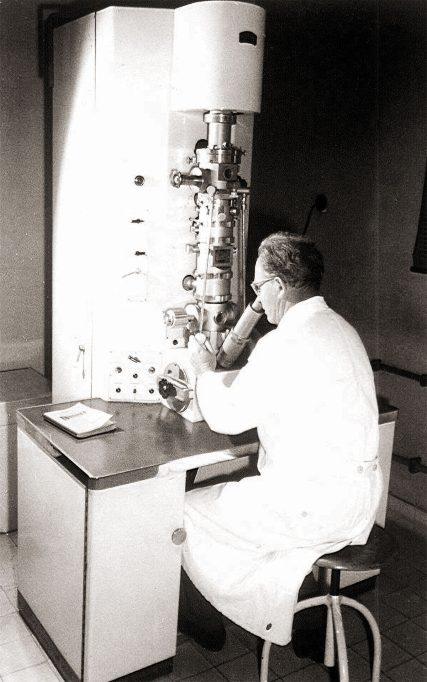
During the 1930s, Hans Beutelspacher started a promising career in Germany in the field of soil science. He demonstrated eager support for Hitler’s regime, joining the Nazi party in 1935, and the German Army in October 1939. During the war, Dr. Beutelspacher conducted a ruthless fight against Soviet partisans in the rear areas of the Eastern Front. The barbaric methods of warfare employed by Dr. Beutelspacher, as well as his ultimate fate, have remained hidden until now. In the image, Dr. Beutelspacher, consumed by work with an electron microscope during the 1960s. / Private archive
For the next two years, Beutelspacher worked as an assistant at the Institute for Plant Nutrition in Hohenheim, and then from the summer semester of 1930 worked on his dissertation at the Higher Technical School in Stuttgart. His scientific supervisor was another German emigrant from Russia, Margarete von Wrangell. In August 1932 a well-regarded scientific journal published an article under both of their names, with the text consisting of an extract from Hans’s future dissertation, which he was being forced to complete on his own; von Wrangell had died the previous March.1Beutelspacher became a Doctor of Agriculture the following year.2
By that time, he was already working in the Technical School in Zürich, having moved to neighbouring Switzerland to gain experience. This does not seem to have been a particularly successful period in the life of the young scientist; he published only a single very brief article (Beutelspacher, 1933). Politically, however, he took an unambiguous stand. After spending almost three years in the alpine confederation, Beutelspacher by March 1935 had succeeded in being admitted to the NSDAP, and a few months later, to the Sturmabteilung (SA) as well.3 His political career, however, failed to advance; preserved in the archive of the Eastern Department of the NSDAP Office of Foreign Affairs is a warning, dated December 1934, against working with him (Archiv des Instituts für Zeitgeschichte, 1934).
In the spring of 1935, Beutelspacher returned to Germany, having finally obtained a position as an assistant at the University of Königsberg, in the Institute of Agronomy. Under the supervision of Eilhard Alfred Mitscherlich, a famous agricultural scientist, Hans’s career experienced an upturn, with several serious publications and with trips to conferences, including abroad (Mitscherlich & Beutelspacher, 1936). In July 1939, Hans was part of an international soil science commission that met in Stockholm. Science, politics, youth – the surrounding order of things was, it seemed, as strict and precise as an equation relating to the chemical elements in the soil.
The blood boils
The German invasion of Poland forced a halt to Beutelspacher’s scientific career. In mid-October 1939 he enlisted in a preparatory signals battalion in Königsberg (5. Kompanie Nachrichten-Ersatz-Abteilung 1). The doctor clearly found military life dull and sought diversion to the extent that he could; at the end of the month, he finished up in an infirmary with a diagnosis of gonorrhea. It seems unlikely that his spouse – since April 1937 he had been married, and his first daughter was to be born in July 1940 – learned of the dissipation in which her rational husband was indulging (BArch Berlin, c. 1939).
By June 1941 Beutelspacher was serving in the intelligence section of the 43rd Army Corps, commanded by General Heinrici – part of the German forces that would invade the USSR later that month in Operation Barbarossa.
After initial victories, the invading German were soon plagued by partisans attacking their supply lines – a challenge they met with indiscriminate violence. In October 1941 Heinrici’s corps began forming teams for anti-partisan warfare. The scientist, now with the rank of lieutenant, was first assigned to one of the anti-partisan detachments as an interpreter (NARA, 1941a), and later was transferred to the headquarters staff of the corps, with responsibility for partisan matters (NARA, 1941b).
Formally, the doctor was listed as a Sachbearbeiter, a specialist, but he began instantly to display unusual zeal. Assembling around him a group of three former Red Army soldiers, the sons of peasants, he began setting out on the hunt every evening. «Our Russian interpreter has taken to the struggle against [the partisans] with exceptional energy» Heinrici wrote. «In the past three days the interpreter has managed to capture and finish off 15 of them, including several women. The partisans are fiercely loyal to one another. They let themselves be shot, but do not betray their comrades» (Hürter, 2016, p. 87).
Unfortunately, we do not have available to us sources that might shed light on Hans’s thoughts, or on how he personally perceived the daily executions. But it is obvious that however unexpectedly, he found the summary killings to be a rational and probably even interesting pursuit for him, one that allowed him to feel useful while providing him with the opportunity to exercise vengeance. In another note, Heinrici records that «On the sixth [of November] alone Beutelspacher captured 60 people, including 40 Red Army troops. He managed to bring in twenty of them and finish them off. They hanged one young lad in the town, that is, Beutelspacher relieved the field police of this melancholy task and carried it out himself…» (Hürter, 2016, p. 87).
The young man he hanged was Aleksandr Chekalin. The sixteen-year-old had been an active member of the Soviet underground and was posthumously awarded the title of Hero of the Soviet Union. In 1944 the town of Likhvin was renamed after him. For seventy years nothing was known about who had hanged Chekalin, with the act ascribed simply to anonymous «Germans».
The forty Red Army soldiers were evidently from divisions that had been encircled and destroyed; ever since, they had been wandering eastward through the forests. After weeks of roaming the thickets, these living corpses could scarcely have mounted the slightest resistance, and a relative handful of soldiers had sufficed to «effectively» carry out their arrest. And execution. Hans does not seem to have felt any pity for the grimy, famished men in bedraggled uniforms, who had lost their human appearance. Had his scientific view of the world simply hardened him further? In precise laboratory formulae, there was no place for sentiment. For the soil scientist, cleansing occupied lands of partisans (or of people considered to be partisans) was perhaps something like applying pest control before sowing. If that were the case, then he was like a powerful insecticidal formula, and his prisoners were merely harmful parasites.
Beutelspacher made friends with the general, advising him to read Tolstoy and Leskov to understand Russia. In the intervals between battles Heinrici did, indeed, set about mastering Russian literature. At times Beutelspacher’s zeal for his job got on Heinrici’s nerves. «I told Beutelspacher not to hang partisans closer than a hundred metres from my window. Not the most pleasant sight in the morning» (Hürter, 2016, p. 88).
The general’s personal displeasure, however, did not deter Beutelspacher from pressing ahead. By the beginning of 1942 he had already been awarded three decorations.
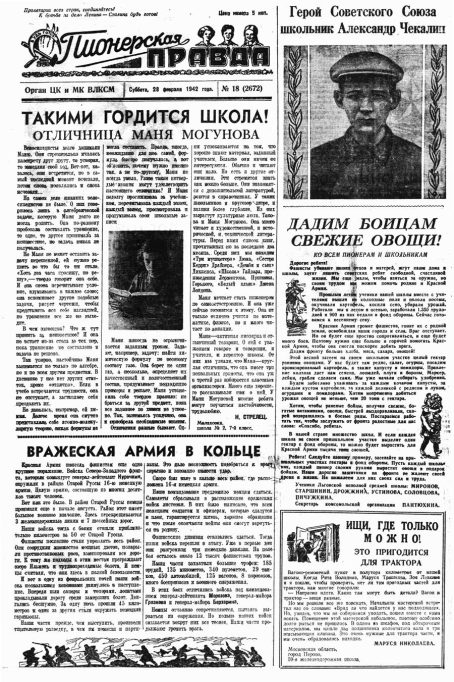
Soviet newspaper Pioneer’s Truth promoting the life story of Aleksandr Chekalin (February 1942), a sixteen-year-old who had been an active member of the Soviet underground and was later awarded the title of Hero of the Soviet Union. The caption on the second page reads: «Shura Chekalin’s life is an example for you, lads!». In November 1941, Hans Beutelspacher participated directly in his capture and execution. According to reports, Beutelspacher himself hanged Chekalin. / Russian State Children’s Library (RGDB)
The most dangerous game
Beutelspacher’s work as an interpreter now lay behind him, just as he had, it seems, allowed his university life to slip irretrievably into the past. He had become a true professional of the manhunt and the rope. When he had entered the Wehrmacht two years prior, he could scarcely have imagined that under his leadership he would soon have hundreds of men, an entire squadron.
The basis of the future Beutelspacher group consisted of fourteen Cossacks, former soldiers of the Red Army. Among them, there were two officers, ten non-commissioned officers and a lance-corporal, men who had earlier served in the German Ski-Bataillon Schlebrügge. This battalion, under the command of Major Hans von Schlebrügge, had been formed in early January 1942 and had immediately been thrown into battle near Iukhnov and Spas-Demensk. The unit had given a good account of itself, in February and March thwarting a number of breakouts along a fifty-kilometre sector of the front. The troop of Cossacks had also distinguished themselves, and this may have helped ensure that they would be separated off into a distinct formation.
The paths of the Cossacks and of the Doctor of Soil Science thus intersected. From 1 May 1942 Beutelspacher, now a Senior Lieutenant, began to reinforce the Cossacks with volunteers from the prisoner of war camps. By 1 June 1942 a formation referred to as the «self-defence group under the 43rd Army Corps», and numbering close to 180 men, had been created. The unit consisted of one commander, three officers, fifteen non-commissioned officers and 157 soldiers. The personnel were Cossacks (51 %), Russians (37 %), Ukrainians (5 %), Tatars (3 %), Belarusians (3 %), Poles (0,5 %) and Chuvash (0,5 %) (TsAMO RF, 1942a). The squadron was divided into three platoons led by lieutenants Sidorenko (1st platoon) and Bogatyriov (2nd platoon), who had earlier been part of the Ski-Bataillon, and also by the commander of the reconnaissance platoon Sharapov (NARA, 1942).
The aim of establishing such formations was to solve an urgent problem – the need to guard the rear of the 4th Army and to ensure an uninterrupted flow of supplies along the railway. The army that General Heinrici headed in January 1942 had survived its first winter at war only with difficulty, after spending several months in virtually complete encirclement and almost ceasing to exist. During the summer of 1942 large-scale anti-partisan operations were being mounted throughout the rear of Army Group Centre, and the doctor thus found himself in a highly favoured position.
Beutelspacher’s Cossacks were conducting small operations from the early days of June. One of the groups against which the squadron fought was the 1st Cavalry Guards Corps of General Pavel Belov, that was active in the rear of the 4th Army and had been inflicting losses on it since the winter. The Beutelspacher group combed through the forests, sought out and destroyed partisan camps, and seized equipment and prisoners, of whom it had already captured eighty by 18 June (NARA, 1942). The squadron spent the entire summer and autumn of 1942 on the northern bank of the River Ugra, in the village of Chashchi in the Vskhody Region of Smolensk Province. As well as conducting military operations, the squadron involved itself in subordinating the local population to German rule, imposing and collecting levies of food and other goods, and appointing the heads of local administrations. By 15 August the squadron had taken as many as 600 prisoners and killed 67 partisans. Its own losses amounted to three wounded and three killed (NARA, 1942).
The methods of conducting operations did not differ from those of the previous year, and included extra-judicial reprisals, as was described memorably in one of the partisan reports: «[The Russian police] detachments organise round-ups of our people. They line up those they have detained in groups of twelve to fifteen and ask them: who of you is for Hitler, and who is for Stalin? All those who do not answer as desired are sent as prisoners of war to a concentration camp, and anyone who resists is killed. Those who go over to the enemy are… given weapons and uniforms, and are enlisted in the Cossack detachments» (Kozhin, 1942).
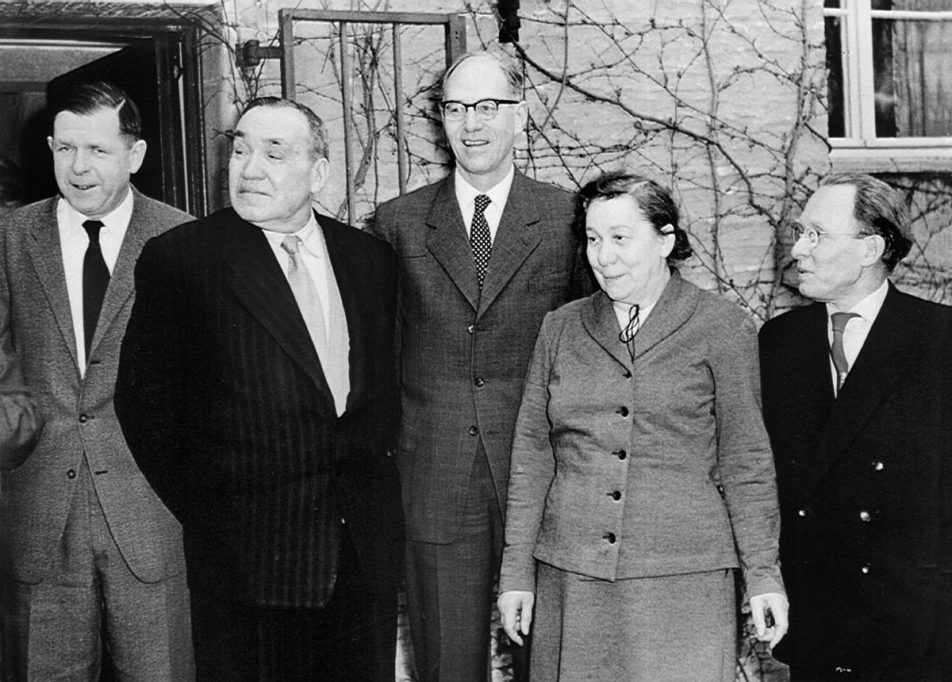
Dr. Beutelspacher (far right) with colleagues in November 1958. He is standing next to visiting Soviet scientist Professor Mariia Kononova, whose work he translated into German. / Private archive
The commanders of the 43rd Army Corps were satisfied both with the doctor’s methods and with the results achieved by his squadron. On 5 September the Cossack «veterans» who had earlier served in the Ski-Bataillon Schlebrügge were awarded the Ostmedaille; Beutelspacher himself had received it a month and a half earlier (Beutelspacher, 1949; NARA, 1942). Beutelspacher’s Cossacks scoured the remote corners of their operations zone, searching through out-of-the-way villages, and sought to determine the moods of the local population. In the autumn the peasants were gathering weapons that had been dispersed about the forests, and the doctor reported the possibility that preparations were under way for creating new partisan detachments (NARA, 1942). By the end of November, it had been decided that the squadron, which by this time had swollen to 235 members, would be expanded into a Cossack battalion to be assigned the number 443 (TsAMO RF, 1942b).
The Cossack Battalion was not the only «native» unit in the 4th Army, which nevertheless failed to solve its problem with partisans. And of course, despite all the praise these units received, their training and discipline remained substantially inferior to those of their German counterparts. The officers exchanged experiences, and to further this process, a decision was taken late in the year to establish an «Eastern school» under the army staff, where Soviet citizens fighting for the Germans could learn the science of anti-partisan warfare. To head these accelerated «officers’ courses», it was proposed to appoint Beutelspacher (NARA, 1942). The doctor did in fact establish a school, but at the end of January 1943 he surrendered control over it, when the Cossacks were transferred to the neighbouring 3rd Tank Army (NARA, 1942). According to a report compiled by the Soviet authorities after the liberation of the Vskhody Region, as many as 80 % of the dwellings in the region were burnt during the occupation, and more than 4.000 people were sent off to work in Germany.4
In the zone of ashes
It was not only the military unit to which the Cossacks were subordinated that changed, but their geographical location as well; from the Ugra, they were sent 400 kilometres to the north-west, and came to be based in the town of Pustoshka in Pskov Province. There, in an effort to solve the problem represented by partisans in the rear of two armies, they mounted active military operations. Scouts were sent into the forests, prisoners were taken, deserters with goods and equipment were received, and partisan camps were burned. The dry phrases of military documents rarely permit any refining of details, or allow one to determine whether the «partisans» who were recorded in the reports actually were participants in the Soviet underground, or were merely scared peasants who had fled from their homes. There is no doubt that indiscriminate violence was being directed against the civilian population, even if this was against a background of military operations against armed combatants. One of the Cossacks who fought in the battalion, and who earlier had deserted from the partisans, described one of the military actions in detail: in a fierce battle, the Cossacks overran and destroyed a partisan camp that was equipped in exemplary fashion and had contained several hundred people. After the battle most of the Soviet patriots managed to escape, but invariably in such camps there were also unarmed civilians who had fled into the forest. The second column of the Batallion captured seven people. «They made no statements and were shot. As they were being shot, I noticed that they made the sign of the cross. I doubt that they were really partisans!» (Silvestrov, 1950).
In June 1943, Beutelspacher’s Cossacks helped drive the local residents out of the villages of Shalashovo, Denisovo, Timonovo, Novava (Iurovo), and Gorka (Berezno Lake), to be sent off to forced labour. First, the Cossacks were required to try to convince the population that the German regime was strong and that its presence was permanent; the aim of this propaganda action was to entice people from their hiding-places, in order then to conduct a round-up and to deliver the people forcibly to the point from which they would be dispatched (NARA, 1943a). The Cossacks helped to guard the wagons containing the involuntary recruits, trying to prevent the partisans from staging attacks. In one instance, partisans attacked a train in an attempt to free the people who were being transported away; the Germans and their Cossack allies then mounted a fire-fight that involved the use of heavy weapons (NARA, 1943b).
Of course, there were also cases in which the Eastern units of the Wehrmacht established more or less neighbourly relations with the population, on whom they depended and among whom they lived. It does not seem, however, that this was true of Beutelspacher’s battalion, which through its acts had embittered the locals. A woman who had witnessed the battalion’s operations recalled its soldiers as being loyal to their commander, savage in their actions, and given to robbing the population. At times the Cossacks entered villages while pretending to be partisans, in order to expose partisan sympathisers. There is no need to dwell on the fate that awaited those who revealed themselves as supporters of the Soviet regime.
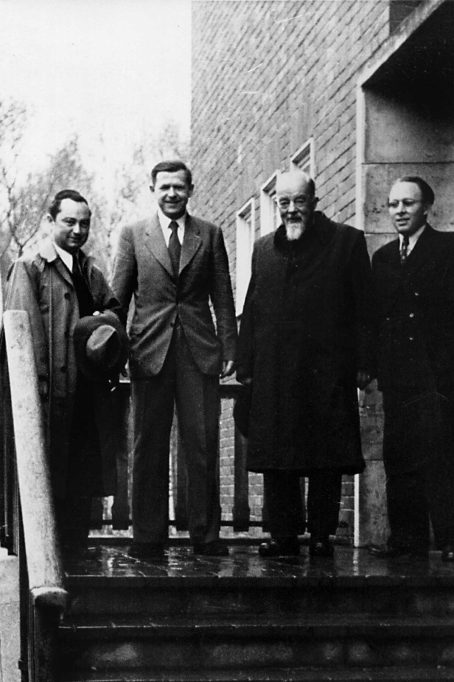
A meeting of minds: second from the left there is Dr. Wolfgang Flaig and next to him Professor Eilhard Alfred Mitscherlich, both old colleagues of Dr. Beutelspacher (first from the right, wearing spectacles). By the 1950s, he had managed to resume his scientific career, now at the Institute of Soil Biochemistry in Braunschweig. / Private archive
There are other testimonies as well. Even one of the Cossacks acknowledged after the war that the battalion contained a good many repellent individuals. Lieutenant Sharapov, now having acquired the 3rd Squadron, was «interested in nothing apart from women, geese, ducks, piglets and bees, all of which he dragged around with him». Beutelspacher himself hated Communists, and «carried on with women». The 4th Squadron of Lieutenant Filatov behaved in vile fashion; it pillaged, raped, engaged in mass shootings, and did everything conceivable to destroy the population’s trust in the battalion. A memoirist sought to pin the blame for these acts on provocations by Soviet intelligence agents, said to have infiltrated the unit. Local residents complained to Beutelspacher, who despite being «like an old oak», nevertheless proceeded to give Filatov a carpeting. The latter sought to justify himself by claiming that to act otherwise was impossible; this, he said, was how one «fought against partisans». Things reached the point where a German major was sent from the higher staff to investigate the crimes. Beutelspacher covered for his subordinate, Filatov, blaming everything on the Germans, since Russians were supposedly incapable of inflicting violence on Russians. The investigating major appeared satisfied with this, departed, and closed the case. The doctor boasted subsequently about the way he had managed to extract himself so dexterously from the situation. For the suffering population, the only resort was to cross over to the partisans (Silvestrov, 1950).
Early in June 1943 Hans was promoted to captain (NARA, 1943c). In one of his reports he recounted that when the Cossacks conducted sweeps through the forests, the population would lie to them under questioning, trying to give them a distorted picture of the strength and location of the Kalinin partisan brigades that were active in the region. The members of the population either supported the partisans of their own accord or were being forced to make peace with the armed people from the forest. As Beutelspacher put it, hiding places were being prepared in the villages, weapons and explosives were being stockpiled, and military positions were being equipped. Meanwhile, the Cossack punishment squads were in any case uninterested in questions relating to the guilt of civilians and to their forced or voluntary coexistence with Soviet patriots; for the Cossacks, material evidence of a partisan presence, or merely a suspicion of collaboration, was enough. In a «punishment» action on 28 September 1943, Beutelspacher’s team burnt down the villages of Elovka, Ovinishche, Gusino, and Dubrovo. On the following day Pavlovo, Aleksandrovo, Glukhovka, Luzhki, Skuraty, Pogary, and Sviblovo were destroyed (NARA, 1943d).
Naturally, such acts of terrorism could only serve to strengthen the partisan resistance, and this in turn brought a continuation of the violence on the part of the occupiers. Almost immediately, a further action followed. According to a report by Beutelspacher, intelligence findings made it possible to determine the villages that were the bases of support for several partisan brigades that were presenting a potent obstacle to the occupiers in the region. To render the operations of the underground more difficult, a decision was taken to turn the region into a «dead zone», which would involve the levelling of all structures and the burning of all crops within a defined area. In the first half of October, the 443rd Cossack Battalion, reinforced by German units, burned down 33 villages while killing thirteen «bandits» and capturing three; its own losses amounted to six wounded (NARA, 1943b). The aim of this savagery was to end the physical ability of the partisans to supply themselves from the surrounding countryside. The fact that this would effectively doom most of the local population to die of hunger during the coming winter was not taken into account even as «collateral damage». For the population, there was no place in the chemically precise equation of violence worked out by the doctor of soil science.
It cannot be excluded that this outburst of violence also had an external cause: the battalion was out to prove its loyalty and was binding its military criminals together with blood (or in this case, fire). In the summer and autumn of 1943, the officers and men of the Eastern battalions had begun deserting to the Soviet side in whole groups and sub-units. The reasons for this included the military victories of the Red Army and the complete failure of Berlin to provide the «volunteer fighters against Bolshevism» with a political rationale for their service; the effect of this failure had been to turn the «volunteer fighters» into pure mercenaries. On 19 July 1943 some 47 legionaries who had been serving in the elite Brandenburg regiment, and who had shared with the 443rd Cossack Battalion the task of guarding the rear in the Pustoshka region, rose in revolt. The legionaries shot fourteen of their fellow soldiers, and in two trucks, deserted to the side of the 2nd Kalinin Brigade (NARA, 1944a).
Such episodes multiplied throughout the German rear, from the Baltic to the Black Sea, with the result that the command of the Wehrmacht ground forces was forced to take a decision to transfer the Eastern battalions westward, further from the line of the front. The 443rd Cossack Battalion (which together with the corps had by this time had been incorporated into the 16th Army of Army Group North) had also appeared on the initial lists of forces to be transferred (Reports Army Group North, 1943). The corps command, however, spoke out sharply against this decision, stressing that the battalion was «reliable», that it had «especially recommended itself», and that it was needed not only to resist the pressure from the partisans, but also to maintain surveillance over the construction battalions that were preparing a line of entrenchments in the Pustoshka Region, and that consisted of volunteer collaborators (HiWi, abbreviation of Hilfswillige) (Reports Army Group North, 1943). The battalion was struck from the lists at the last moment. It should be noted that at that point the number of deserters to the Soviet side from the 443rd Battalion was indeed less than the average for the Eastern units. Reports by partisans mention a greater proportion of prisoners rather than deserters in the 443rd Battalion (RGASPI, 1943).
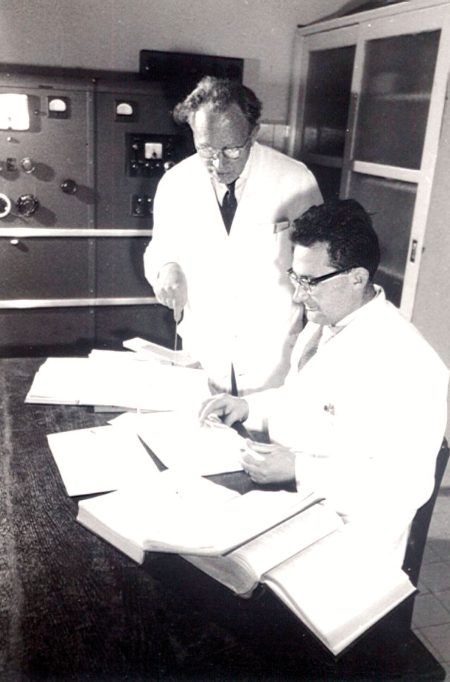
Dr. Hans Beutelspacher (standing) with his colleague Dr. Egbert Rietz, with whom, along with Dr. Wolfgang Flaig, he cosigned his most cited work to date. End of the 1960s. / Private archive
In early November 1943 the battalion was placed temporarily at the disposal of the 1st Army Corps, to participate in the large-scale anti-partisan Operation Heinrich to the south-west of Pustoshka. While the operation was under way, however, Soviet forces broke through the line of the front, as a result of which the German command had no choice but to throw the 443rd Cossack Battalion into closing the breach, along with the 631st Cossack Battalion that was also taking part in the anti-partisan sweep (BArch Freiburg, 1943). Beutelspacher’s unit remained on the front lines for about ten days, from 9 to 18 November, though as early as 13 November the doctor made an urgent request that it be retired to the rear, since he could no longer guarantee the reliability of his men. Supporting this request, the corps command employed the somewhat paradoxical argument: «The Cossacks see their task as being only to free the rear of bandits, and consider battles with the Red Army to be fratricidal» (NARA, 1943b).
The corresponding order came too late; on 16 November the Cossacks were in the line of an attack by Soviet tanks near the village of Lakushi. They were driven from their positions and put to flight. Among those who abandoned the field of battle was the commander of the 3rd Squadron, Sharapov. Nevertheless, the battalion’s losses proved not to be great. To prevent such a debacle from being repeated, the command of the 43rd Army Corps transferred the battalion away from the front line. Back in the rear, the unit continued throughout the winter and spring of 1944 to put into effect the policy of fire and sword (NARA, 1943b; NARA, 1944b).
To the west
Continuing pressure from the Soviet forces compelled the German command to transfer the corps from place to place, and in March 1944, the 443rd Cossack Battalion finally took its leave of the 43rd Army Corps, though for several more months it remained in approximately the same region and pressed ahead with its struggle against the partisans. In the spring of 1944 Beutelspacher was promoted to the rank of major and was awarded the infantry assault badge. In the course of the operation Waldschneise (‘Forest Clearing’) alone, the battalion in early June 1944 killed 92 partisans and took another 41 prisoners, with losses to itself of only five dead (NARA, 1944c). Early in July 1944 the battalion retreated to Latvia. Not long before this the earlier-mentioned squadron commander Filatov, with a group of fifteen men, had gone over to the partisans (Silvestrov, 1950).
Doubts about the battalion’s reliability forced the 18th Army, in whose complement it had finished up, to keep it in reserve (NARA, 1944d). In late September the battalion was transferred to Poland, where it covered the rear of the 9th Army to the south-west of Warsaw (NARA, 1944e). Since the army had accumulated more than a half-dozen different Eastern battalions in its rear, the idea arose of combining them into a brigade, and of placing it under the command of the former Russian prisoner of war General Assberg (real name Artsezo), who had served as an inspector on the staff of a general of volunteer forces and had come to Poland with the inspection. Within a few days, however, Assberg left the army as a result of «events of an extra-service nature» (NARA, 1944e).
In Poland the battalion guarded railways and continued fighting partisans, though the latter were now Polish. The Wehrmacht was trying actively to recruit Polish volunteers to its ranks, (NARA, 1944e) and perhaps as a result of this the modus operandi of the battalion changed: partisans were now for the most part taken prisoner, rather than being liquidated on the spot. There were, however, still excesses; near Biała Rawska on 15 December one of the Cossacks mistakenly shot a German stormtrooper (Archiwum Akt Nowych, 1944).
In mid-January 1945, along with other units of the 9th Army, the 443rd Battalion bore the main brunt of a powerful Soviet offensive that compelled the German forces to retreat hurriedly to the west. In early February the rear region of the 9th Army was thus on German territory, in Fürstenwalde am Spree. The complaints by local residents describe vividly the behaviour of the Cossacks during the retreat, and the military habits that held sway in the unit; the Cossacks took over their hosts’ bedrooms, slaughtered their chickens, stole gold watches, broke open the suitcases of civilian refugees, made advances to the women, and threatened to shoot anyone who protested (BArch Freiburg, 1945a).5
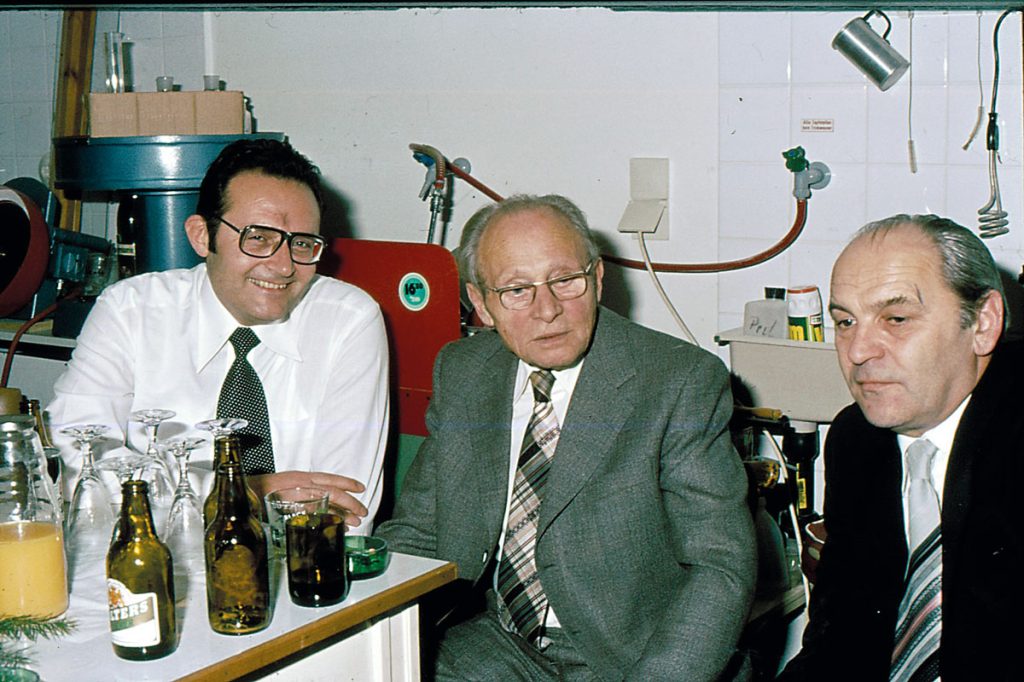
A friendly shindig with colleagues in December 1977. Dr. Beutelspacher is in the middle. He headed a department in the Institute of Soil Biochemistry in Braunschweig, where his subordinates remembered him as a stern chief who at the same time knew how to be kind and did not shy away from social gatherings. Sometimes he would recount anecdotes about the war or his childhood in Odessa but remained silent about his hunt for partisans. / Private archive
Soon after this, the remnants of the Cossack battalions were transferred further south to the region of the town of Spremberg, where in early March Soviet saboteurs were active in the rear of the 4th Tank Army. For the most part, the Eastern units were used for digging entrenchments (BArch Freiburg, 1945b). In the last weeks of April, the German units that had been defending Spremberg were encircled, but the Cossacks by this time appear to have fled. According to an eyewitness, the officers in Spremberg abandoned their squadrons. Together with a remaining group of soldiers, Beutelspacher made for Czechia; he did not want to surrender to the Americans, and especially to the British, whom he described as having «negative qualities». Near Karlsbad the group split up, Beutelspacher taking with him the 4th Squadron. The above-mentioned witness, who later did not encounter a single man from the squadron in the camps in western Germany, suggests that Beutelspacher led the unit to the Soviet forces (Silvestrov, 1950).
The rope twists
Despite his professed antipathy to the British, Beutelspacher, two months after the end of the war, was to be found in the British zone of occupation, five hundred kilometres from Karlsbad, in the village of Unterstedt, near Rotenburg an der Wümme in Lower Saxony. There he met up with his wife, who perhaps had been evacuated there from Königsberg. In filling out a form that threatened «the most severe penalties» for false information, Beutelspacher nevertheless lied, stating that his last posting had been with Division z.b. V. 172, that during the war had been located in the rear or on the Western Front (Beutelspacher, 1945).6 He would scarcely have suspected at that time that he would remain in Lower Saxony for the rest of his life.
Four years later, when undergoing denazification in Osnabrück, he no longer concealed his service in the 43rd Army Corps. The decorations that he honestly admitted to having received, and that included the Bandit Warfare Badge or Anti-Partisan Badge, might have led the denazification commission to guess that Beutelspacher had in fact served on the Eastern Front. The commission, however, was not interested in these details; from its point of view Beutelspacher was neither a convinced National Socialist nor a professional soldier, categories that were subject to checking. He was merely a professional chemist, and on this basis was excluded from the list of persons to be investigated. Further, he was excused from having to pay a charge of 20 marks, on the grounds that he was effectively indigent.
The first postwar years were indeed difficult for Beutelspacher’s family, that now consisted of four people (a second daughter had been born in 1944). He tried to become an entrepreneur, producing humus, but failed to prosper and was forced to go to work for an agricultural research laboratory, while the family remained housed in a refugee barracks.
The botched denazification, however, proved a turning point for Beutelspacher’s career; within a month he found employment as a researcher with the Institute of Soil Biochemistry that was part of a broader agricultural research institution in Braunschweig. The director of the institute was the soil scientist Wolfgang Flaig, with whom Beutelspacher co-authored several dozen articles in the period between 1950 and 1975. To these should be added the articles that Beutelspacher wrote on his own or with other co-authors; the overall number of his publications probably approaches 100. The scientist’s specialty became the electron microscopy, with the help of which he sought to make his contribution to soil science. If we are to judge by the citations index, he was successful; one of his last publications, perhaps his magnum opus, has been cited more than a hundred times, and researchers to this day continue to refer to it (Flaig et al., 1975).
In the mid-1950s the Braunschweig institute where Beutelspacher worked established contacts with Soviet soil scientists. Early in 1958 the institute was visited, in response to an invitation from Flaig, by the distinguished Soviet soil scientist Mariia Kononova, who left an expression of her gratitude in the visitors’ book. It is evident that by this time Beutelspacher’s anti-Bolshevist moods had finally left him, since employing his knowledge of the Russian language he welcomed his guests warmly and graciously saw to their needs, posing with pleasure next to them in a photograph. That same year Kononova’s book Humus substances of the soil appeared in a German translation by Beutelspacher, with a foreword by Flaig (Kononova, 1958).
Far more astonishing than Beutelspacher’s moral metamorphoses is the fact that the Soviet Chekists did not search him out (or at any rate, were unable to identify him) after the war. His military career began in 1941 with the hanging of a future hero of the Soviet Union, and until the very end of the war consisted exclusively of anti-partisan operations, executions and the burning of villages. The number of victims of the battalion he headed is in the four figures. He should have figured in at least three war crimes investigations, relating to events in Tula, Smolensk, and Pskov provinces. At times, it is obvious, even Soviet Chekists did not search where they needed to, but only beneath the light.
In 1959 Beutelspacher was elevated to the position of scientific advisor, that was equal to the rank of a state civil servant and that carried with it a substantial pension. He headed a department in the Institute of Soil Biochemistry, where his subordinates remembered him as a stern, exacting chief who at the same time knew how to be kind and did not shy away from dinner-table gatherings with young colleagues. At times, over a glass, he would recount something about the war or about his childhood near Odessa, but this reminded his listeners of exaggerated «hunters’ stories». About his real hunt for partisans, of course, he kept silent. Beutelspacher retired in 1970, but for some years after that continued publishing scientific works. He died in Braunschweig on 19 March 1984.7
A postwar photograph depicts Hans Beutelspacher looking into a microscope, sitting with his back to the viewer. In a surprising way, this acts as a metaphor for his life: only through using a historical «electron microscope» are we able to penetrate into his secret. If he were to turn around, which of his faces would we see – that of the keen scientist, or that of the merciless killer?
References
Archiv des Instituts für Zeitgeschichte. (1934, December 13). Umlauf [note]. 128/3 unpag. München, Germany.
Archiwum Akt Nowych. (1944). SS- und Polizeiführer im Distrikt Radom Ic Ereignismeldung [document]. 2/1335/0/23/187. L. 93. Archivum Akt Nowych, Warsaw, Poland.
BArch Berlin. (1935, November 1). Mitgliedschaft des Volksgenossen H. Beutelspacher [note]. R 9361-II/72566. Bundesarchiv Berlin, Germany.
BArch Berlin. (c. 1939). Zentrale Personenkartei [card]. B 563/ZK-B-575/158. Bundesarchiv Berlin, Germany.
BArch Freiburg. (1943). Kos. Btl. 631, Tätigkeits- u. Gefechtsbericht für die Zeit vom 30.10-15.11.43 [report]. RH 24-1/282, Bl. 175-185RS. Bundesarchiv Freiburg, Germany.
BArch Freiburg. (1945a, February 24). Beeinflüssung der Stimmung der Zivilbevölkerung durch das Verhalten von Wehrmachtseinheiten [document]. RH 2/2129, Bl. 174. Bundesarchiv Freiburg, Germany.
BArch Freiburg. (1945b, April 6). Bandenlage im Monat März 1945 [report]. RH 2/2130, Bl. 152RS. Bundesarchiv Freiburg, Germany.
Beutelspacher, H. (1933). Die Agrikulturphysik und ihre Beziehungen zur Bodenarbeitung. Mitteilungen der Deutschen Landwirtschafts-Gesellschaft, 48, 1042–1044.
Beutelspacher, H. (1945). ZA 11/ Örtliches Kontrollblatt P. 4 [form]. Bundesarchiv Berlin, Germany.
Beutelspacher, H. (1949, July 22). Fragebogen für die politische Uberprüfung [form]. Abteilung Osnabrück Rep 980 Nr. 33853. Niedersächsisches Landesarchiv (NLA), Hannover, Germany.
Flaig, W., Beutelspacher, H., & Rietz, E. (1975). Chemical composition and physical properties of humic substances. In J. E. Gieseking (Ed.), Soil Components, Vol. 1, (pp. 1–212). Springer. https://doi.org/10.1007/978-3-642-65915-7_1
Hürter, J. (2016). Notizen aus dem Vernichtungskrieg: Die Ostfront 1941/42 in den Aufzeichnungen des Generals Heinrici. WBG.
Kerus, K. A. (1943, April 1). Report of NKVD Captain Kerus to NKVD Chief of the Smolensk Region, Commissar of the State Security P. P. Kondakov [report]. F. R-1630. Op. 1. D. 317. L. 3. State Archive of Smolensk Province, Smolensk, Russia.
Kononova, M. (1958). Die Humusstoffe des Bodens: Ergebnisse und Probleme der Humusforschung. Deutscher Verlag der Wissenschaften.
Kozhin, Senior Battalion Commissar. (1942, August 10). Report of Senior Battalion Commissar Kozhin [excerpts from the report]. F. P-8. Op. 2. D. 151. L. 17. State Archive of Modern History of Smolensk Province, Smolensk, Russia.
Mitscherlich, E. A., & Beutelspacher, H. (1936). Die Umwandlung der anorganischen Stickstoffverbindungen in organische mit Hilfe der Pflanze. Schriften der Königsberger Gelehrten Gesellschaft, Naturwissenschaftliche Klasse, 13(5), 159–184.
NARA. (1941a). Anlage 562 zum Kriegstagebuch General-Kommando XXXXIII. A. K [addenda]. NARA T314 (Roll 1005). National Archives and Records Administration, Washington DC, United States.
NARA. (1941b). General-Kommando XXXXIII. A. K., ‘Partisanenbekämpfung,’ [order]. NARA T315 (Roll 1275). National Archives and Records Administration, Washington DC, United States.
NARA. (1942). Kriegstagebuch des XXXXIII. A. K [official diary]. NARA T314 (Roll 1010). National Archives and Records Administration, Washington DC, United States.
NARA. (1943a). Herausziehung der wehr- u. arbeitsfähigen Bevölkerung zum Arbeitseinsatz [document]. NARA T314 (Roll 1019). National Archives and Records Administration, Washington DC, United States.
NARA. (1943b). Kriegstagebuch des XXXXIII. A. K [official diary]. NARA T314 (Roll 1011, 1014). National Archives and Records Administration, Washington DC, United States.
NARA. (1943c). Morgenmeldung [report]. NARA T314 (Roll 1014). National Archives and Records Administration, Washington DC, United States.
NARA. (1943d). Bericht über die Bandenbekämpfung im Gebiet zwischen Swidlo- und Jasno- [report]. NARA T314 (Roll 1019). National Archives and Records Administration, Washington DC, United States.
NARA. (1944a). Beiträge für den Tätigkeitsbericht [document]. NARA T314 (Roll 1019). National Archives and Records Administration, Washington DC, United States.
NARA. (1944b). Kriegstagebuch des XXXXIII. A. K. [official diary]. NARA T314 (Roll 1016). National Archives and Records Administration, Washington DC, United States.
NARA. (1944c). Befehl für das Bandenunternehmen Waldschneise [document]. NARA T314 (Roll 159). National Archives and Records Administration, Washington DC, United States.
NARA. (1944d). Kriegstagebuch AOK 18 [official diary]. NARA T312 (Roll 957). National Archives and Records Administration, Washington DC, United States.
NARA. (1944e). Kriegstagebuch AOK 9 [official diary]. NARA T312 (Roll 343). National Archives and Records Administration, Washington DC, United States.
Reports Army Group North. (1943). Abgabe von landeseigenen Verbänden aus dem Bereich der Heeresgruppe Nord [reports]. RH 19-III/252, Bl. 10, 12, 18, 21. Bundesarchiv Freiburg, Germany.
RGASPI. (1943). Reports from 12 July and 30 September 1943 [reports]. F. 69. Op. 1. D. 709. Russian State Archive of Socio-Political History, Moscow, Russia.
Silvestrov, no first name. (1950, April 23 and May 2). Letters to Vladimir Pozdniakov [letter]. MSG 149/59, Bl. 111–112, 132. Bundesarchiv Freiburg, Germany.
TsAMO RF. (1942a). Selbstschutz-Verband des Gen.-Kdo. XXXXIII. A. K., 18 August 1942 [report]. F. 500. Op. 12454. D. 413. L. 247. Central Archive of the Ministry of Defence of the Russian Federation, Podolsk, Russia.
TsAMO RF. (1942b). Antrag auf Etatisierung einer Kos. Abt. bei Gen. Kdo. XXXXIII. A. K., 22 November 1942 [report]. F. 500. Op. 12454. D. 639. L. 262, 264. Central Archive of the Ministry of Defence of the Russian Federation, Podolsk, Russia.
Notes
1. The dissertation, containing a brief autobiography, was published as: Hans Beutelspacher, Methode zur Bestimmung geringer Kaliummengen in Bodenlösungen (Hohenheim, 1933). Go back.
2. His personnel form stored at the University of Göttingen Archive stipulated that Beutelspacher became a Doctor of Agriculture on 31 March, 1933. Go back.
3. After Beutelspacher moved to Königsberg, the party chancellery informed the local Gau (the unit of the administrative divisions of Nazi Germany) that he was recorded in their card-index as a member of the Foreign Organisation of the NSDAP, party number 3604455 (BArch Berlin, 1935). Further correspondence on this matter is absent. After the war, Beutelspacher denied his membership in the NSDAP. Go back.
4. According to the report, villages were put to the torch at an especially high rate when the German forces were retreating in February1943; whether the battalion remained in the Vskhody region until this time is unclear from the available documents (Kerus, 1943). Go back.
5. We have no way of establishing whether the Cossacks belonged to the 443rd Battalion or to some other Cossack unit of Korück 532 (Kommandant des rückwärtiges Armeegebietes — Rear Army Area Commander). Go back.
6. It should be noted that no information has been preserved in the Information Centre of the Wehrmacht on Beutelspacher’s service between 1941 and 1945, and in particular, on his service in the 43rd Army Corps. Confirmed in a letter from BArchBerlin, 27 March 2020. Go back.
7. This was confirmed by a telephone conversation with former a colleague of Beutelspacher, R., on 22 November 2018, as well as the Stadtarchiv Braunschweig in April 20 2021, based on Death Certificate No. 828/1984 (E 34: S. 490). Go back.


